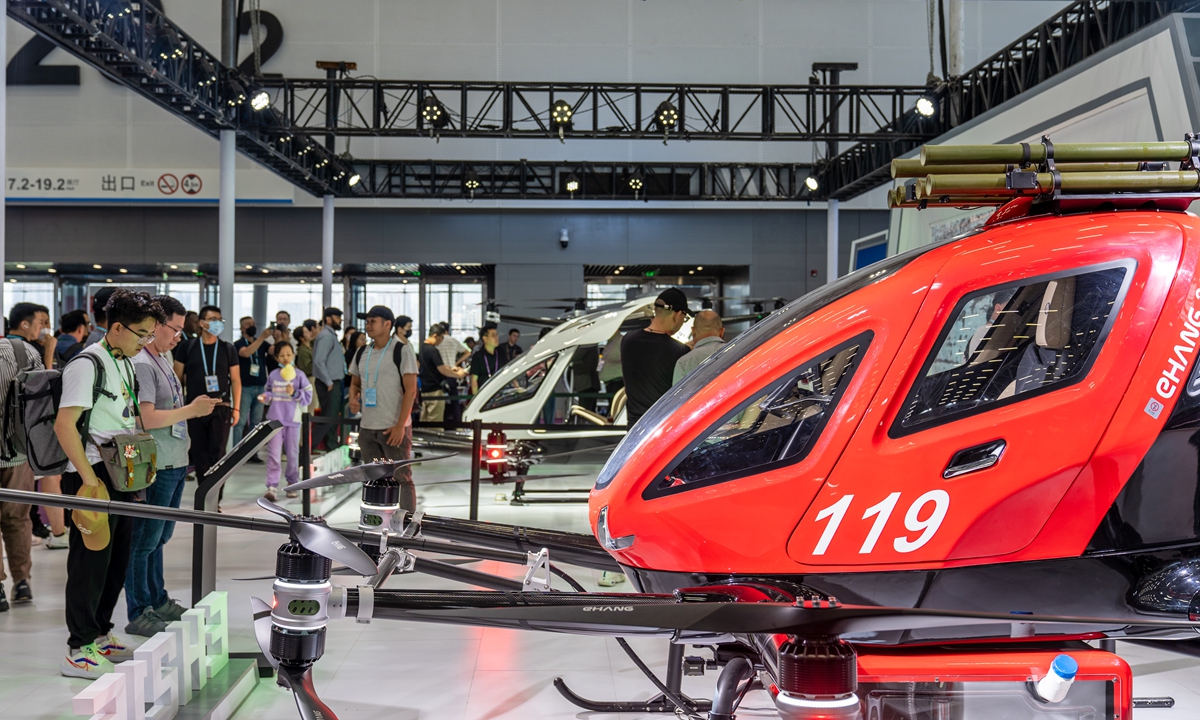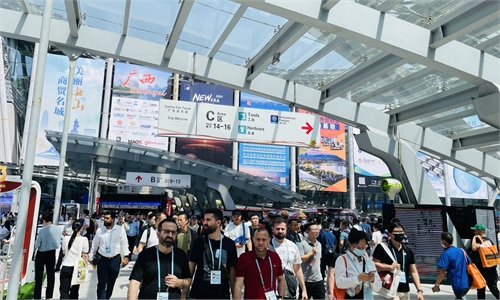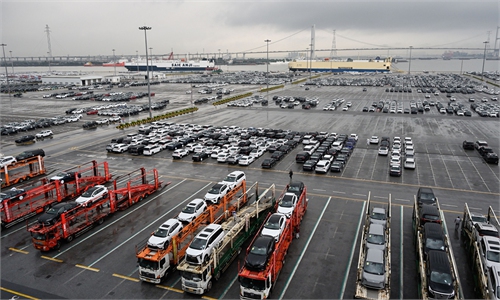China fleshes out new basket of trade policies against 'complex, severe' environment

Visitors inspect intelligent electric autonomous aerial vehicles produced by EHang Intelligent Technology Co at the 133rd session of the Canton Fair on April 17, 2023. Photo: Chi Jingyi/ GT
China has fleshed out a new basket of policies to stabilize foreign trade, including resuming on-site trade fairs and stabilizing trade of major products such as vehicles, amid what Chinese officials flagged as "complex, severe" foreign trade environment that is clouded by lingering uncertainties in external demands as well as a bunch of downward pressures at home.
The measures come after China's export juggernaut started off on an upbeat note, with March exports expanding a rosy 14.8 percent in dollar-denominated terms - the first time the figure landed in positive territory since October 2022.
The new policies, adding to a flurry of measures that have already been effective, are "timely boosts" aiming to guard the fast-lane recovery momentum, while also fixing the potential softness in the trade sector particularly as global liquidity may become strained and geopolitical tensions flare up in the remaining part of the year, observers said.
Industry insiders also described the government policies as "beating the drum" for an uphill yet must-win battle for Chinese traders. With such top-down fighting spirit, it is expected that the country's foreign trade, one of the three economic wheels that some foreign doomsayers claimed could lose steam, could climb by between 3 percent and 5 percent this year, propelling China's annual GDP growth to top over 5 percent, analysts said.
"China's foreign trade has achieved a 'head start' in the first quarter. But we must acknowledge that China's foreign trade situation is complicated and severe, and has been confronted with multiple difficulties," Chinese Vice Minister of Commerce Wang Shouwen told a press conference organized by the State Council Information Office on Sunday.
At the press briefing, China's Ministry of Commerce, along with the central bank and the General Administration of Customs, issued a bunch of measures and guidelines on foreign trade, with goals to stabilize trade volume and optimize trade structure.
"Based on trading companies' appeals, the measures accommodate both [the situation] at present and long-term," Wang elaborated. "They're also more targeted and forward-looking."
Detailed measures include creating trade opportunities such as resuming fully offfine expos, improving the efficiency of APEC business travel card issuance, and facilitating the orderly resumption of international passenger flights.
Other policies on the list also include stabilizing the trade of major products, such as helping auto firms to set up global marketing service system.
"[Those moves show that] China is proactively seeking to adjust its foreign trade structure, optimize trading partners and expand the advantage of competitive industries," Chen Jia, an independent analyst on global strategy, told the Global Times on Sunday.
Downward pressures
"It is predicted that the recovery of trade could be a relatively weak spot this year compared with other growth mainstays such as consumption and investment. So a robust recovery streak in foreign trade, on the back of policy shore-up, would augur well for a full-fledged rebound to take foothold this year," Tian Yun, former vice director of the Beijing Economic Operation Association, told the Global Times on Sunday.
Wang said that externally, the biggest constraint on China's foreign trade roots in the uncertainty in external demand.
The IMF has downgraded the global economic growth forecast from 2.9 percent in January to 2.8 percent in April, and it projected that slowdown will be more pronounced in advanced economies.
The grim external situation is visible among China's neighboring countries which have recorded relatively big slumps in foreign trade in recent months, according to Wang.
As such, industry insiders raised the urgency of tackling with external chill. They said external risks such as US hegemony and protectionism on global trade, credit crunch in the Western banking industry and the excessive rate hikes of the US Fed should be "well noted," otherwise it could create a big headache dragging down China's recovery.
Chen expects the batches of government supports to instill new vigor and buffer against external disruptions.
For example, the measures on creating more trade opportunities will further expand China's trade volume with economies in ASEAN and along the Belt and Road Initiative, which have been a new growth point in China's import and export structure in the first three months. Policies involving vehicle exports could also give full play of China's trade advantages in new energy, automobile, mechanical and electrical and green development.
Resilience, advantage
Moving to the second quarter of the year, China's trade sector has been operating at full throttle - evidently from the bustling ports, diligent Chinese traders, to just-concluded crowded first phase of the China Import and Export Fair (Canton Fair) - all of which speaks volume for the sector's vitality and resilience regardless of the pressures.
Huang Jianlun, a manager with the container terminal at Guangzhou Nansha Port in Guangzhou, capital of South China's Guangdong Province, told the Global Times on Sunday that foreign trade volume is increasing from the same period of last year judging from the number of container lorries and transit cargo boats entering and leaving the terminal.
Port of Guangzhou, which operates a number of ports including the Guangzhou Nansha Port, is the world's fifth largest port.
In recent months, foreign demand for energy storage facility is increasing and as a result, solar products, batteries and new energy vehicles manufactured by domestic brands are becoming the "new three major" growth drivers for exports, Huang said.
Simultaneously in Guangzhou, the 133rd Canton Fair which opened in mid-April, has received swarms of foreign purchasers.
Zhang Nasu, general manager of Ningbo Saiding Electric Appliance Co, told the Global Times on the sidelines of the Canton Fair that this year's total overseas income of the company will definitely exceed that of 2022. The company had a surprising overseas income in the first quarter that already topped 10 million yuan.
Industry insiders agreed that one of the biggest strengths in China's foreign trade is stable supply. Whenever and no matter how many products their customers order, they are available to supply, with customized services. "Higher quality and more competitive price help us face external challenges," Zhang explained.
A total of $12.8 billion worth of export deals were signed during the first phase of the 133rd Canton fair from April 15 to 19, data from the Ministry of Commerce showed.
Chinese traders, based on a sober understanding of a challenging global environment, have also been putting extensive business focuses on developing new customers to buffer against external shockwaves.
"We plan to participate in an industry exhibition in the mid-year. As China reopens, a number of foreign clients will fly in to join the exhibition for the first time in three years," Duan Lianmin, a manager at a Shenzhen-based glass factory, told the Global Times, indicating that her company will seize the opportunity to develop new customers in addition to existing clients in Southeast Asia, the Middle East, India and South Africa.
As the export sector functions in full swing, economists expect the momentum of trade recovery to continue to be "in the sweet spot," and to expand 3 percent to 5 percent in yuan-denominated terms for the whole year.
That will underpin China's annual GDP to grow by 5 percent, continuing to serve as both a stabilizer and a locomotive for global economy, analysts noted.



